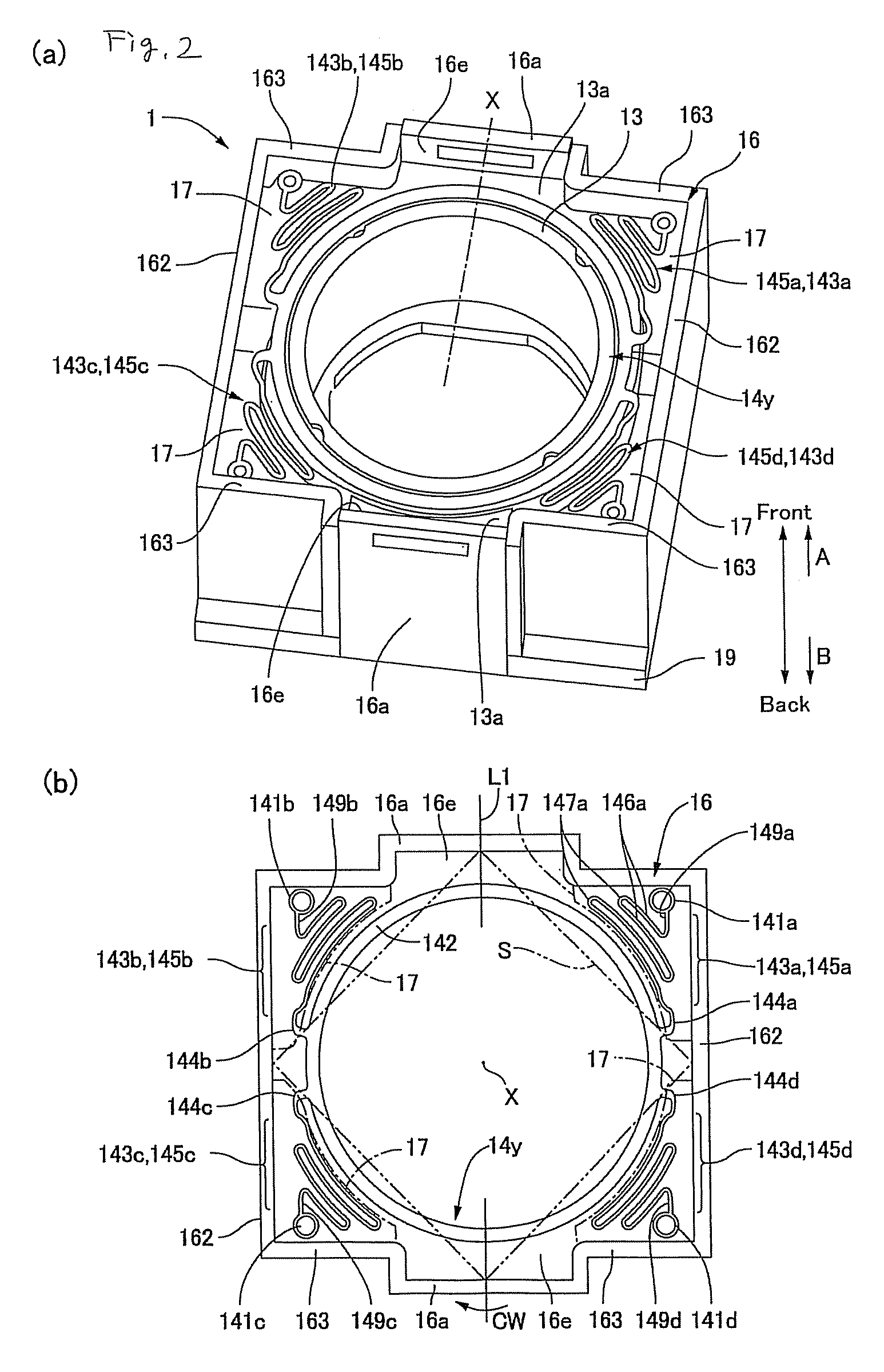Lens driving apparatus
a technology of driving apparatus and lens, which is applied in the direction of printers, instruments, cameras, etc., can solve the problems of degrading the performance increasing the time and cost of manufacturing, and complicated manufacturing process of the lens driving apparatus, so as to reduce the entire lens driving apparatus, simplify the configuration, and prevent the manufacturing process from becoming complicated
- Summary
- Abstract
- Description
- Claims
- Application Information
AI Technical Summary
Benefits of technology
Problems solved by technology
Method used
Image
Examples
embodiment 1
Overall Configuration
[0048]FIG. 1 (a) and (b) are respectively an external appearance view of the lens driving apparatus of Embodiment 1 of the present invention, observing the front of the apparatus diagonally from the top, and a perspective disassembly view.
[0049]Used in thin cameras such as digital cameras or camera phones, the lens driving apparatus 1 of this embodiment shown in FIG. 1 and FIG. 2 (a) moves three lenses 121 in both the A direction (to the front) and the B direction (to the back) along the optical axis, the A direction in which the lenses are moved toward a photographic subject (toward an object) and the B direction in which the lenses are moved in the opposite direction from the photographic subject (toward an image). It is in a rectangular parallelepiped. The lens driving apparatus 1 has a movable body 3 holding a cylindrical lens barrel 12 equipped with the three lenses 121 and a fixed aperture inside thereof, a drive mechanism 5 that moves the movable body 3 a...
modification example of embodiment 1
[0098]FIG. 6 is a horizontal cross-sectional view of a lens driving apparatus of Modification Example of Embodiment 1. In the lens driving apparatus 1 shown in FIG. 2, the magnetic circuit is constituted by the back yoke 16, the magnets 17, and the coil 30; however, an inner yoke 21 may be added to form the magnetic circuit as in a lens driving apparatus 1A shown in FIG. 6 (a). In this way, a magnetic flux can be induced in a desired direction (leakage of magnetic flux can be reduced), providing the stable electromagnetic force.
[0099]As in a lens driving apparatus 1B shown in FIG. 6 (b), the shape of the coil 30 may be changed to use it as a stopper. In other words, the coil 30 moves together with the sleeve 13 in the moving-coil-type lens driving apparatus 1B; for example, when the sleeve 13 is displaced upwardly in the figure by some kind of shock, the coil 30 is also displaced and a modified portion 30a of the coil 30 (an example of the extension portion) makes contact with the m...
embodiment 2
[0102]FIG. 7 is a plan view of a lens driving apparatus of Embodiment 2 of the present invention, with the cover off. Since the basic configuration of this embodiment remains the same as Embodiment 1, the overall configuration is described referring to FIG. 1 (a) and (b), and the same codes are given to the common members and their description is omitted.
[0103]As shown in FIG. 1 (a) and (b), even in the lens driving apparatus 1 of this embodiment, the spring members 14x and 14y are respectively arranged between the back yoke 16 and the holder 19 and between the back yoke 16 and the case 11. The spring members 14x and 14y share the same basic configuration; therefore, the spring member 14y arranged between the back yoke 16 and the case 11 is used to describe the configuration.
[0104]As shown in FIG. 7, the spring member 14y is provided, in the same manner as Embodiment 1, with four small annular outside joint portions 141a, 141b, 141c and 141d held between the back yoke 16 and the cas...
PUM
 Login to View More
Login to View More Abstract
Description
Claims
Application Information
 Login to View More
Login to View More - R&D
- Intellectual Property
- Life Sciences
- Materials
- Tech Scout
- Unparalleled Data Quality
- Higher Quality Content
- 60% Fewer Hallucinations
Browse by: Latest US Patents, China's latest patents, Technical Efficacy Thesaurus, Application Domain, Technology Topic, Popular Technical Reports.
© 2025 PatSnap. All rights reserved.Legal|Privacy policy|Modern Slavery Act Transparency Statement|Sitemap|About US| Contact US: help@patsnap.com



